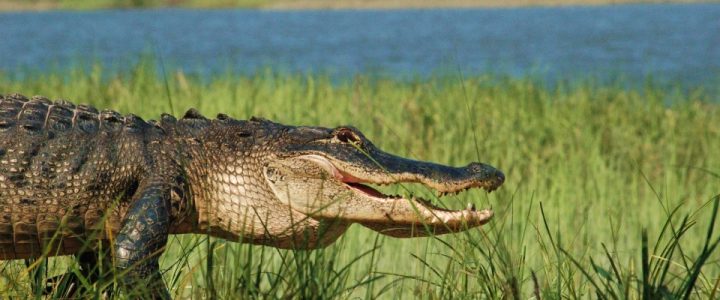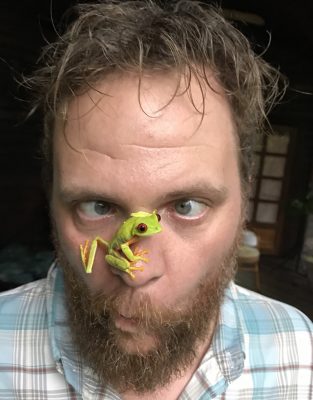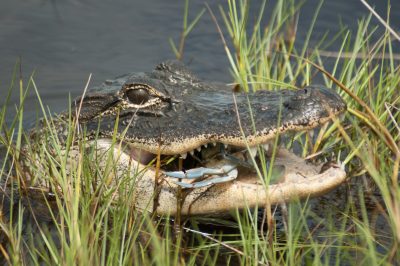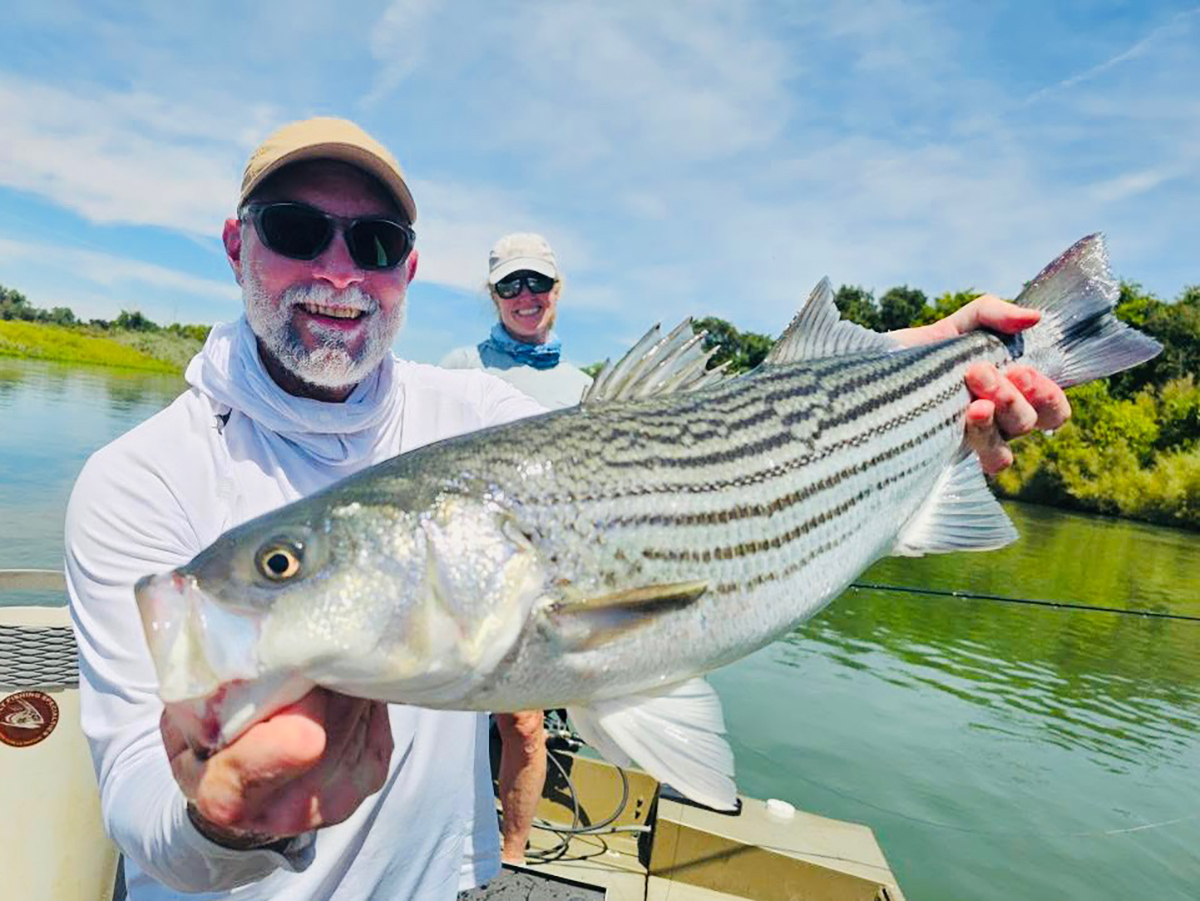
Mornings like this find themselves permanently etched into our memories, teetering on the edge of reality and dreamscape. Though it seemed as if I might drown in humidity, the stillness of the atmosphere was arresting. And the result? Sea and sky were one as heaven and earth joined at the horizon in perfect mirrored reflection. Clouds above, clouds below.

I was plying the shallows around a place called Middle Marsh, a tangle of spartina and oysters and mud and periwinkle snails with a small egret rookery thrown in for good measure. This wetland sits at the mouth of the North River between Beaufort and Harkers Island, and from the air it looks like some sort of cubist painting by Pablo Picasso that has begun to wash away. Strange lines, angles and patterns make up this salt marsh. The whole thing is laced with various tidal creeks and a proper dusting of duck blinds. The tide was high and the place thoroughly flooded thanks to the new moon that day. I was looking for tailing redfish, but what I found was something altogether very different.
Supporter Spotlight
Sunning itself in the lime green cordgrass that so dominates these salt marshes, was a dinosaur – otherwise known as an alligator. With my outboard raised high on its hydraulic jack plate, I eased my way in for a closer look. This wasn’t my first Carolina crocodilian. I have spent countless hours kayaking and photographing these ancient creatures along the blackwater recesses of our inner banks and knew they showed up in our estuaries from time to time, even occasionally being spotted on the beach. But this was my first chance encounter with one in the salt. Bottlenose dolphins worked their trade in the channel just beyond this marsh and I had stirred up a green sea turtle with tell-tale sunburst pattern on its shell as I first began to ease across the flats. Now here I was, leaning over the side of my skiff peering into the prehistoric eyes of an alligator where oyster beds and stingrays should be.
This could be considered a chance encounter, a fluke if you will. Up and down the Southeast coast, whenever an alligator shows up on the saltier side of things, we generally assume they were flushed out of rivers by heavy rains or the ebb of king tides. We have a century’s worth of biology to go by, which has told us this is not where alligators are supposed to be.
But we humans are a funny lot, big-brained and all tangled up in the stories we tell ourselves. We try to catalogue and classifying everything under the sun and pass off our understanding of the world to posterity. Wading through this collective knowledge, we scrutinize the past and craft euphemisms like “change is the only constant.” But knowledge and belief are two very different things. And so we become resolute in our assumptions, believing deep down that everything has always been, and always will be, exactly like it is right now.
In the realm of the life sciences, we have come to call this “shifting baseline syndrome.” Sound scary? You should probably be afraid. It’s contagious, life threatening and reached pandemic levels a long time ago.
A hundred years ago, we had the world of American crocodilians neatly organized. Alligators belonged in freshwater swamps, while only the American crocodile could be found in the saltwater – though confined to the Gulf Coast of south Florida. This makes sense. It’s where they were found at the time, albeit after 300 years’ worth of persecution. We also thought they were both just dumb reptiles that were better off exterminated to make way for the new top dog in town.
Supporter Spotlight
At that time, nobody knew that alligators could drink from a lens of freshwater that can be found floating atop of saltwater. Nor did we know that both alligators and crocodiles collect sticks on their noses to lure in wading birds who are searching for nesting material – a little behavior we like to call tool use. And it wasn’t until the late 1960s that Robert Paine discovered the concept of keystone species through his work with sea stars on the coast of Washington, right when alligators were being placed on the Endangered Species List.
Today, we talk of concepts like shifting baselines syndrome in regards to our perception of what is and what is not normal. The whole idea was first put forth by the fish biologist Daniel Pauly and was in reference to the state of fisheries. Granddad’s stories of the good old days of fishing were just that: stories, nothing more. Hauls were never that big. Fish, never that numerous. At least that is what we believe – based on our own personal experience. And thus, we fail to grasp what the population of fish once were before our generation’s turn at catching them and especially before commercial fisheries developed.
The world that we are born into is what we accept as reality and assume that on some fundamental level reflects the way things have always been. And so, in Massachusetts for instance, Nantucket natives and the old salts of Cape Cod argue that the presence of 30,000-plus grey seals is unnatural, that great whites shouldn’t be in those waters and the whole ecosystem and that all their fisheries are going to fall apart because of it. Yet, we know from historical records that this is exactly what the place looked like when European fishermen first arrived and could fill a boat with cod by simply dipping baskets into the water – when fishing was at its all-time best. We now know that abundance begets abundance.
What is to say that when science first began to level its gaze at alligators in the early part of the 20th century, that those biologists themselves weren’t already suffering from shifting baseline syndrome? By that point, Europeans and their descendants had spent about 300 years working on the wholesale destruction of all things predator. Long before such things as wildlife biologists and ecologists ever existed, our civilization had been hard at work remaking the world to its liking.

Brian Silliman, a marine science and conservation professor at the Duke University Marine Lab in Beaufort, argues in a new paper published in the journal Current Biology (download pdf), that this may be exactly what happened. As we enter this new era of conservation success, a time when we are finally beginning to witness real results from such legislation as the Marine Mammal Protection Act and the Endangered Species Act, a lot of those rebounding animals aren’t exactly doing what they are supposed to.
Today, we are watching as alligators become a regular fixture in salt laden estuaries from Texas to North Carolina. Studies are revealing that species like sharks and rays are regularly making up the diets of these reptiles presumed to be strictly freshwater in nature. Seals, once thought to be a denizen of the far north, are showing up with clocklike regularity on the Outer Banks and the subtropical waters of the Crystal Coast. Sea otters in California, a species associated with Pacific kelp forests, are also beginning to populate salt marshes – a habitat they were ever known to occupy. It’s like Nature Gone Wild out there.
Silliman refers to these species as the ghosts of nature’s past. His argument is not that alligators are really a saltwater species, of course. Crocodiles have specialized glands for expelling salt, whereas alligators do not. Instead, he argues that maybe, just maybe, what we are seeing is not accidental at all, but could very well be a matter of species re-inhabiting old haunts that they were driven from long before we started paying attention.
Studies dating back to the late 1970s reveal that gators were readily found in our state’s salt marshes at a time when their population was at its lowest. Down south, around Cape Canaveral, research shows that gators are found in dense numbers across seagrass beds and in mangroves – places that we once assumed to be the exclusive domain of sharks, sea turtles and American crocodiles. Other studies have identified alligators inhabiting full-blown marine ecosystems for up to a week straight before returning to the slightly less-salty waters of estuaries.

But here’s the thing: When it comes to alligators and saltwater, there is a solid correlation with protected habitats. Back in the early 1980s, here in North Carolina, salty gators were three times more common in the protected salt marshes of our national seashores than elsewhere. Alligators living in the Florida Keys do so only in those mangroves and creeks that fall within National Park lands. And all those seagrass beds at Cape Canaveral that alligators are making their living around, have been protected by the Kennedy Space Center. Simply put, it would appear that alligators are only beginning to occupy saltwater environments where people do not. Even my saltwater alligator falls into this category as Middle Marsh is a part of the Rachel Carson Estuarine Reserve.
All this begs a question about North Carolina then. When we find alligators hanging out in Middle Marsh, or on the beaches of Brunswick County, should we continue to assume that it’s all accidental? The official story is that they were probably just flushed down river by heavy rains. But what if that is not the case at all? What if we are beginning to witness the return to old estuarine haunts?
All of this could have very real consequences for the continued success of species that are beginning to make a comeback. If legislation is written to protect habitat for endangered species, then what does it mean when their habitat extends well beyond the boundaries we once presumed they functioned within?
The idea of conservation success is new to us. Since the 19th century, when Americans first began to wake up to the impact that we had on the ecosystem and neighboring species, the story of doom and gloom has remained the same. More habitat loss. Populations continuing to dwindle. Another species pressed over the edge of oblivion. Though all is not yet right in the world, hard work is beginning to bear fruit. And this is something that nobody is ready for. We don’t even know what success really looks like. Is it 30-50,000 gray seals and a thriving population of great white sharks? Alligators lounging around on National Seashore beaches? This has not been part of the national conversation.
What does it truly mean for a species to be recovered? Is it when a population reaches a magic number pulled out of a geneticist’s hat and fits nicely into the sterility of legislation? Or is it when a species has re-occupied its home range and has resumed the ecological role it once played there? What if we don’t even know what that home range really was? And, given the fact that each and every one of us alive today suffer the delusional fevers of shifting baseline syndrome, should our assumption of what “recovery” looks like automatically trigger a hunting season?
So many questions yet to be answered.
I never did catch any fish. So taken by my discovery of that alligator laying up in the salt marsh, I lost track of time. As anyone with much experience in tidal creeks knows, you are always working on borrowed time in there. Everything is planned according the ebb and flow of tides – when you can enter, when you should leave. As both time and tide slipped by under the hull of my boat, I found myself overtaken with that sickening feeling that occurs when you suddenly and unexpectedly feel the sharp jolt of solid ground beneath your boat. Hopping into what water that was left, I grabbed my bow line and took my boat for a walk on its leash back to deeper water. Glancing over my shoulder, I watched 6 feet of alligator slip out into the gin-clear waters of the shallow channel and disappear into an estuary where it is probably supposed to be, but we are not yet ready to admit.







